Ski-Doo Re-Launches the MX Z X-RS

Race-bred suspension technologies trickle down the entire line
At the 2010 Snow Shoot, it was abundantly clear—handling and suspension performance are top priorities for the manufacturers. And all of them are battling for top honors. For the upcoming season, Polaris has unveiled the Rush, which carries a radical new cantilever rear suspension with outboard mounted rear shock. Arctic Cat has morphed the Sno Pro 600 snocross chassis and suspension into the trail-calibrated Sno Pro 500. Yamaha’s top terrain sled, the Nytro RTX SE, features race-oriented shocks and other premium equipment. And Ski-Doo, the pioneer in rider forward technology, is reintroducing the MX Z X-RS, a trail sled that’s a bonafide racer replica of its MX Zx 600 RS snocross sled. This season an aggressive trail rider or ditch banger certainly has a lot to choose from.
After a one-year hiatus, the MX Z X-RS rejoins the lineup as the ultimate production terrain sled from Ski-Doo. This is no warmed over MX Zx with bold graphics, rather the X-RS uses a host of high-performance equipment, race-type shocks, and the Zx 600 RS snocross chassis. This includes wider, stronger running boards, tunnel to running board bracing, and a steering post that’s been positioned farther forward for a snocross riding position. In addition, the X-RS receives a sculpted seat that’s 1.25 inches higher and designed for aggressive riding, so the rider easily transitions to a stand-up riding position. In terms of suspension performance and calibration, the X-RS is stiffer and more aggressive than the MX Zx yet it is not nearly as stiff as the full-snocross MX Zx 600 RS race sled.
Race-Proven
To provide confidence inspiring and big performance, Ski-Doo has equipped the X-RS with the same shocks as the snocross sled — the KYB racing-type 40mm gas shocks.
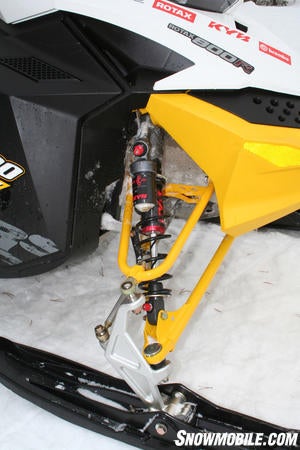 The dual A-arm front suspension carries the KYB 40-R shocks with remote reservoirs. On the remote reservoir chamber, the dial adjusts low-speed damping while a 17mm nut handles high-speed compression damping. At the top of the shock rod, the low-speed compression damping dial adjuster is located at the top of the shock rod.
The dual A-arm front suspension carries the KYB 40-R shocks with remote reservoirs. On the remote reservoir chamber, the dial adjusts low-speed damping while a 17mm nut handles high-speed compression damping. At the top of the shock rod, the low-speed compression damping dial adjuster is located at the top of the shock rod.
In the tunnel you will find the SC-5 rear suspension that is very similar to the snocross rear skid design and shock package. It features reinforced slide rails and a four idler wheel rear axle, so the skid can handle the most extreme bump pounding. Similar to the front, you will find a KYB Pro 40 shock on the center and rear arm that provides low- and high-speed compression damping control through a dial and nut adjuster. However, unlike the front shocks, neither shock comes with external rebound damping control.
Since the introduction of the XP chassis, I have been impressed with the balance, precision, and suspension control of the dual A-arm front suspension, SC-5 rear suspension, and REV XP chassis. And each year, Ski-Doo has been refined the suspension calibration, seat foam density and height, and now the steering ratio. After spending some time attacking the bumps on the X-RS, its ultra quick response to rider input, remarkable bump control, and stable handling characteristics were revealed.
Key Refinements
But beyond the ultra high performance MX Z X-RS, Ski-Doo has made a number of key refinements to the REV-X platform and the lineup at large. The REV XP chassis is in its third year of production, and important changes have been made. First, the front suspension has a new steering ratio that requires less steering effort and does not sacrifice steering precision. A new shock and spring calibration reduces diving in the corners and while on the brakes. In addition, Ski-Doo has come up with a higher density seat foam and a slightly taller seat for improved comfort and support.
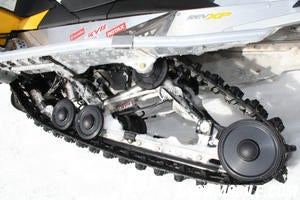 The SC-5 rear suspension in the MX Z X-RS features reinforced slide rails and KYB 40 Pro shocks, which offer external low-and high-speed compression adjustment.
The SC-5 rear suspension in the MX Z X-RS features reinforced slide rails and KYB 40 Pro shocks, which offer external low-and high-speed compression adjustment.
Similar to previous years, the Sport, Adrenaline, and TNT trim levels offer an affordable alternative to the XR-S and X package MX Z class sleds. The Motion Control, steel-bodied gas bag shocks provide the damping duties for the entry-level Sport package. The popular TNT models are equipped with HPG Plus shocks. These aluminum-bodied dampers are rebuildable and tunable but do have remote reservoirs or external damping controls. The Adrenaline model carries HPG Plus shocks up front and the steel-bodied HPG shocks in the rear skid.
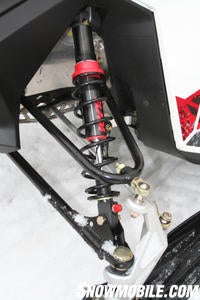 The HPG Plus-R shocks on the MX Z X feature hand adjustable spring preload and rebound damping dial adjuster.
The HPG Plus-R shocks on the MX Z X feature hand adjustable spring preload and rebound damping dial adjuster.
To a large degree, the Renegade (the crossover class) mirrors the trim levels and suspension packages found in the MX Z line up.
The Renegade Sport package offers the Motion Control shocks both forward and aft. The Adrenaline and Backcountry packages carry the HPG Plus shocks up front and HPG aluminum gas-charged shocks in back. The Backcountry X provides a step up to the HPG Plus R shocks with low-speed adjustable rebound damping and Pro 36 shocks on the rear skid. Similar to the MX Z, the Renegade X has HPG Plus R front shocks and KYB Pro 36 rear shocks.
On the touring side, the GSX SE and Grand Touring SE offer Air Control Suspension. A handlebar-mounted switch allows the rider to adjust the preload rate of the rear shock on the fly. So for a plush touring -type ride, the driver no longer has to stop and get out the wrenches to adjust the preload to changing conditions.
Shocks 101: Ski-Doo Fits the Ride to the Rider
To accommodate its wide range of sleds, performance levels, price points, and, of course, models, Ski-Doo offers eight different shocks from the economical hydraulic shocks to piggyback race shocks with full clicker adjustable damping. Without listing every single trim level/shock package in the 2010 product line, I will highlight the most important features of the shock line up. There are four steel-bodied shocks, including the hydraulic steel bodied, Motion Control gas cell, HPG, and the HPG VR shocks. The VR shocks are variable rate, so the shocks have bleed holes that bypass the piston valve stack. In turn, the shock strokes through travel in small stutters for softer more complaint ride. These shocks are found on GSX LE and Grand Touring LE models
The midline to premium models are fitted with take-apart gas charged aluminum-bodied shocks. The HPG Plus is the base aluminum-bodied shock that is rebuildable and revalvable and is found on Adrenaline and TNT models. One step up the ladder, you will find the HPG Plus R shocks, which offers the same features but with dial adjustable rebound. The MX Z X and Renegade X models come with these dampers. Another notch up in the shock lineup and you reach the KYB Pro 36 shocks with 36mm aluminum body – standard equipment on MX Z X and Renegade X rear suspensions. The Pro 36 offers 16 clicks of low-speed compression damping while high-speed is incrementally adjustable through 2-1/4 turns of 17mm hex nut. At the top, the competition ready KYB Pro 40 shocks that provide superlative suspension control for the MX Z X-RS. These shocks are some of the most advanced gas charged shocks fitted to a consumer sled. All the shocks have high and load speed compression damping adjustment while 40-R front shocks have high and low-speed compression damping as well as low-speed rebound damping. The top shock package for the touring is the Air Control Suspension rear spring. It features the soft steel spring dampened by an additional air spring. The shock is controlled by a handlebar-mounted switch that allows five different preload settings for a variety of conditions.



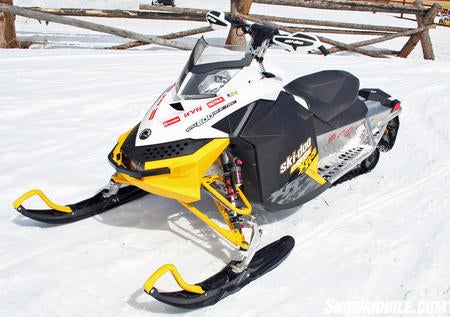
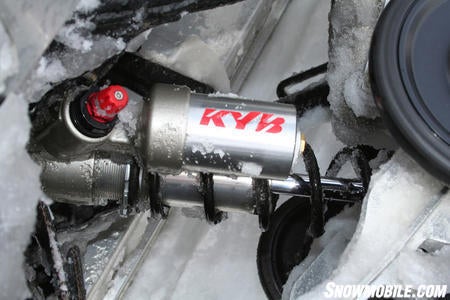

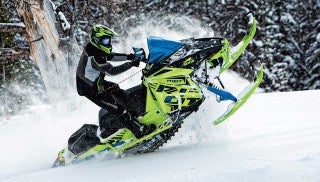
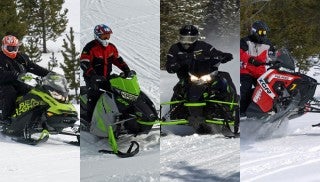


 Your Privacy Choices
Your Privacy Choices